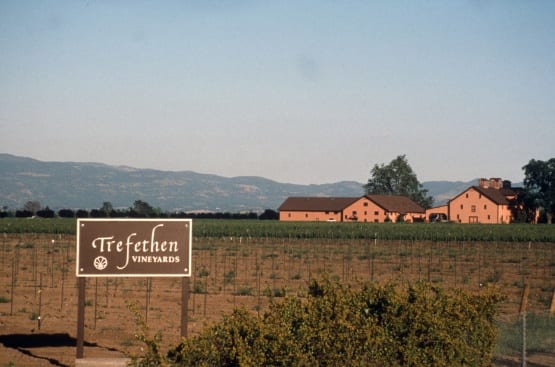The Historic Winery

“The winery, built in 1886, embodied Napa’s first golden age, then lay vacant for decades before being rejuvenated by the Trefethen family. It is a monument to Napa’s rich agricultural heritage, an enduring citadel that combines form and function, a sacrosanct place where grapes are transformed into wine.” -James Laube, Wine Spectator
One of the first wineries visitors see driving up Highway 29, our historic building has stood sentinel over Napa Valley’s vineyards for more than a century. The only surviving 19th-century wooden three-level gravity flow winery in the valley, it is truly one of a kind, and an extraordinary place to appreciate our estate grown wines.
ESHCOL
Commissioned by the Goodman Brothers in 1886, our historic winery was built in a grove of towering oak trees at the center of Eshcol Ranch, directly across the street from the Oak Knoll train station. Designed and built by Captain Hamden McIntyre, who also built Inglenook, Far Niente, Greystone, Beaulieu, Chateau Montelena, Frog’s Leap, and many others, our winery is his greatest work in wood. Immensely framed by stout rectangular posts of Douglas fir and clad in tongue-in-groove redwood siding, the original structure was built so solidly that a visiting writer said that the mezzanine level on the second floor “could have supported the weight of a small locomotive.”
It also presented McIntyre with a unique challenge. Like many of his cellars, it was built as a gravity-flow winery, where grapes were crushed on the third floor, fermented on the second, and aged on the first, utilizing the gentle force of gravity to move from one stage to the next. Unlike his other gravity-flow structures, however, the Eshcol winery was not built into a hill, which would have allowed easy access to the top floor. Instead, considering the valley floor location, Hamden rigged up an ingenious elevator system to raise the grapes up to the top floor, powered by a horse-drawn winch.
It worked beautifully. An article in the Napa Register in 1886 described Eshcol as a “model farm” and the first wines made there helped to establish Napa’s early reputation for quality. At the landmark 1888 California State Viticultural Convention, both Eshcol’s Cabernet Sauvignon and Sauterne wines won first prizes. And at the 1889 Paris Exhibition, in the shadow of the stunning new Eiffel Tower, Eschol wines collected over half of the awards at the wine competition! In 1889, Eshcol was amongst the wines that moved early wine writer and journalist Frona Wait to name Napa “The Banner Wine-Making County” which had come to “lead the State in table wines.”
THE FAWVER YEARS
Unfortunately, the horizon was soon darkening for the burgeoning Napa wine industry. The 1890s were a difficult decade, dominated by the plague of phylloxera, a microscopic aphid that feeds on the roots of vines, leading to infections that decimated vineyards. Over 20,000 acres of vines were present in Napa in 1890 but by 1900 barely 3,000 acres remained. James Fawver, son of a Yountville pioneer, took over management of the Eshcol property during this time, replanting vines that succumbed to the invasive louse and continuing Eshcol’s reputation for fine wine. In 1904, he purchased the property outright as the valley began to recover. By then, he was farming virtually the only vineyard remaining between Carneros and Yountville.
The following years, leading up to Prohibition, were generally good for wine sales, and many Napa wineries expanded, importing grapes from the Central Valley to increase production. Fawver stuck to the estate, however, using only the grapes he grew.
In January of 1919, in the midst of the Spanish Flu epidemic, the unthinkable happened. Over a nine-day period, in an unprecedented deluge of legislative activity, the 18th Amendment went from a frightening possibility to the law of the land as 20 states, including California, ratified it in quick succession. The national Prohibition on the sale of alcohol would begin the following year. Napa County, which voted by wide margins to reject every such proposal, was in shock.
For three years, Fawver continued to make wine, storing it in sheds that he tacked onto the winery in the belief that Repeal was just around the corner. In the meantime, a surprisingly strong trade in grapes emerged, supplying home winemakers on the East Coast. In 1923, Fawver, like so many others in Napa, shifted his business from winery to grape farm.
When Repeal finally came, on December 5, 1933, the country was plumbing the depths of the Great Depression. Undaunted, Fawver reopened Eshcol, making 160,000 gallons that vintage in anticipation of a thirsty market. He was not alone; Napa wineries produced an impressive 5 million gallons of wine in 1933 as the 21st Amendment made its way through state legislatures. Unfortunately, consumer tastes had changed during Prohibition. Accustomed to homemade and bootleg wine and influenced by the meteoric rise of soda pop and packaged foods in the 1920s, consumers didn’t know what to do with this gush of mostly dry, red wine. Fine dining had all but disappeared during Prohibition, and the fine wine market had gone with it. Eshcol reverted to a grape ranch again, supplying the still-strong home winemaking trade the following year. In 1940, James Fawver passed away and his widow leased the Eshcol property to Beringer, who, thanks to their large still, were one of the few wineries able to take advantage of changed tastes in the market, selling over half of their 500,000 gallon production as fortified dessert wine.